Bathroom Readers' Institute's Blog, page 131
August 21, 2014
The Hard Luck of an ‘American Idol’ Reject
Another entry in our series on musicians who just couldn’t get the fair shake they deserved.
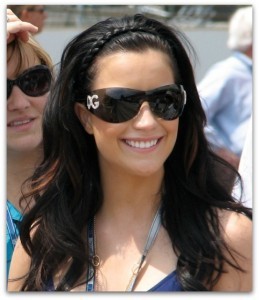 In 1996, Joanna Pacitti was a 12-year-old girl with a tremendous singing voice and landed the title role in a touring production of Annie. The show did so well that producers decided to mount it on Broadway. Just before opening, however, the role of Little Orphan Annie was recast—Pacitti was replaced by her understudy. She and her family sue the producers for breach of contract, but were unsuccessful.
In 1996, Joanna Pacitti was a 12-year-old girl with a tremendous singing voice and landed the title role in a touring production of Annie. The show did so well that producers decided to mount it on Broadway. Just before opening, however, the role of Little Orphan Annie was recast—Pacitti was replaced by her understudy. She and her family sue the producers for breach of contract, but were unsuccessful.
By 2000, Pacitti was 16, and it was when the most popular musical genre was bubblegum pop performed by teenage singers, such as Christina Aguilera and Britney Spears. Geffen Records signed Pacitti, and branding her as just “Joanna,” used her to perform songs for countless movie soundtracks, including Legally Blonde, First Daughter, and Bratz: The Motion Picture. It was a gambit to raise awareness of Pacitti, which Geffen capitalized on by releasing her debut album…six years after singing her. The teen pop fad now distant and stale, This Crazy Life sold just 16,000 copies. Geffen dropped her in 2007.
In 2009, Pacitti auditioned for and made it to the round of the top 36 singers on American Idol. However, fans on American Idol online forums traded rumors that Pacitti was a “ringer,” or a planted professional who has no business performing on a show meant for amateur singers. But Idol isn’t really a show for amateurs—it’s for any singer who at the time of their appearance is not signed to a recording contract. Still, Idol is produced in part by a talent agency called 19 Entertainment. Pacitti’s former manager and best friend: Michelle Young, a high-level employee at 19 Entertainment. (The company also employed Pacitti’s former publicist.) To save face and silence charges that the talent show was somehow rigged, Idol producers kicked Pacitti off the show.
Shortly thereafter, Pacitti joined a pop-rock band called City (Comma) State. Their sole album sold just 10,000 copies…and then they broke up. Pacitti is still singing.
The post The Hard Luck of an ‘American Idol’ Reject appeared first on .
August 20, 2014
A Look Back at Early ‘90s NBA Fight Songs
 Here’s a truly forgotten fad: NBA teams would release slickly produced rap songs to gear fans up for the playoffs. The songs would be played everywhere—but only in the team’s home city—on the radio, at the games themselves, and proceeds from sales of the tapes would go to charity. Prepare to get nostalgic…and cringe.
Here’s a truly forgotten fad: NBA teams would release slickly produced rap songs to gear fans up for the playoffs. The songs would be played everywhere—but only in the team’s home city—on the radio, at the games themselves, and proceeds from sales of the tapes would go to charity. Prepare to get nostalgic…and cringe.
“Rip City Rhapsody” (Portland Trail Blazers, 1990)
The Portland Trail Blazers were the Cinderella team of the 1990 NBA Playoffs, reaching the finals for the first time since the ‘70s. But they had a song ready to go: “Rip City Rhapsody,” featuring players Jerome Kersey and Terry Porter and a sample of the team’s announcer Bill Schonely uttering his catchphrase “Rip City!”
Result: The Blazers lost to the Detroit Pistons, who didn’t even have a rap song.
“Three-Peat Beat” (Detroit Pistons, 1991)
The aggressive, physical play of the “Bad Boys” of the Pistons—Isiah Thomas, Joe Dumars, and Bill Laimbeer—lead the team to two back-to-back NBA Finals wins in 1989 and 1990. They were primed for a third repeat, or “three-peat” in 1991.
Result: There was no three-peat, at least not for the Pistons. They were defeated in the Eastern Conference finals by the Chicago Bulls…en route to that team’s first of two three-peats.
“Not In Our House” (Seattle SuperSonics, 1993)
The main performer on this is Seattle rapper Sir Mix-A-Lot, best known for the 1992 #1 hit “Baby Got Back.” Singing the title over and over on backup: Sonics stars Gary Payton, Eddie Johnson, and Michael Cage.
Result: Despite claiming that a loss wouldn’t happen in their house, the Sonics lost Game 7 of the Western Conference finals to the Phoenix Suns.
Did your favorite NBA team have a rap song we forgot about? Tell us about it in the comments.
The post A Look Back at Early ‘90s NBA Fight Songs appeared first on .
August 18, 2014
5 Stars Who Got Their Start on Talent Shows
You know that Kelly Clarkson got her start as an unknown singing on a TV talent show, but how about the rest of these celebrities?
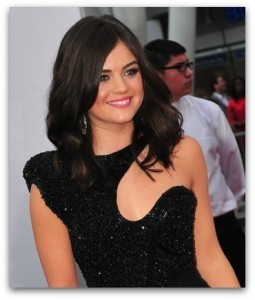 Just after the second season of American Idol, in summer 2003, Fox launched a spinoff called American Juniors: American Idol for little kids with big voices. Instead of one winner, five were ultimately chosen and they formed a short-lived singing group. One of those five was Lucy Hale, who went on to star on the popular ABC Family teen soap Pretty Little Liars.
Just after the second season of American Idol, in summer 2003, Fox launched a spinoff called American Juniors: American Idol for little kids with big voices. Instead of one winner, five were ultimately chosen and they formed a short-lived singing group. One of those five was Lucy Hale, who went on to star on the popular ABC Family teen soap Pretty Little Liars.
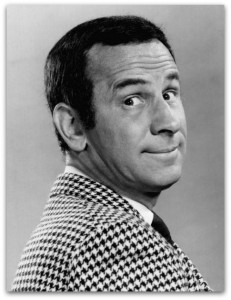 First on radio and then on TV, Arthur Godfrey’s Talent Scouts ran from 1948 to 1958 on CBS and launched the careers of many singers, actors, and musicians who won and who didn’t win. In 1954, a standup comic won. It was Don Adams, who would later star in Get Smart and Inspector Gadget. (He also starred on The Bill Dana Show with the titular comic, who actually wrote the routine that won him Talent Scouts.)
First on radio and then on TV, Arthur Godfrey’s Talent Scouts ran from 1948 to 1958 on CBS and launched the careers of many singers, actors, and musicians who won and who didn’t win. In 1954, a standup comic won. It was Don Adams, who would later star in Get Smart and Inspector Gadget. (He also starred on The Bill Dana Show with the titular comic, who actually wrote the routine that won him Talent Scouts.)
 Star Search was a weekend TV staple from 1983 to 1995, with Ed McMahon hosting up-and-coming singers, dangers, comedians, and “spokesmodels” competing for their big break. Many huge stars competed, but didn’t win, including Sharon Stone (spokesmodel, 1984), Drew Carey (comedy, 1988), Justin Timberlake (male vocalist, 1993), and Beyoncé (female vocalist, 1993). The most famous winner is arguably David Archuleta, who won on a 2003 revival of Star Search four years before he’d place second on another talent show, American Idol.
Star Search was a weekend TV staple from 1983 to 1995, with Ed McMahon hosting up-and-coming singers, dangers, comedians, and “spokesmodels” competing for their big break. Many huge stars competed, but didn’t win, including Sharon Stone (spokesmodel, 1984), Drew Carey (comedy, 1988), Justin Timberlake (male vocalist, 1993), and Beyoncé (female vocalist, 1993). The most famous winner is arguably David Archuleta, who won on a 2003 revival of Star Search four years before he’d place second on another talent show, American Idol.
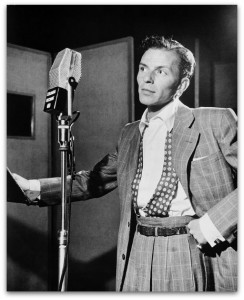 This final one wasn’t a televised talent show, because it was on the air in the 1930s, so it was a radio show. Major Bowes Amateur Hour was a hugely popular show, similar to today’s The Voice or American Idol, although hosted by Edward Bowes, a very serious New York theater manager. In 1935, a New Jersey singing group called the Hoboken Four successfully made it onto the show. Fans called or mailed in their votes, and the Hoboken Four took home 40,000—enough to win first place and a six-month touring contract. Probably the most famous member of the Hoboken Four: Frank Sinatra.
This final one wasn’t a televised talent show, because it was on the air in the 1930s, so it was a radio show. Major Bowes Amateur Hour was a hugely popular show, similar to today’s The Voice or American Idol, although hosted by Edward Bowes, a very serious New York theater manager. In 1935, a New Jersey singing group called the Hoboken Four successfully made it onto the show. Fans called or mailed in their votes, and the Hoboken Four took home 40,000—enough to win first place and a six-month touring contract. Probably the most famous member of the Hoboken Four: Frank Sinatra.
 In 2004, VH1 launched a talent search to fill out a revival of the Partridge Family band. The plan was to use the series In Search of the new Partridge Family to lead into a musical-sitcom series. The sitcom didn’t happen, but cast as Laurie, the part originated by Susan Dey: Emma Stone.
In 2004, VH1 launched a talent search to fill out a revival of the Partridge Family band. The plan was to use the series In Search of the new Partridge Family to lead into a musical-sitcom series. The sitcom didn’t happen, but cast as Laurie, the part originated by Susan Dey: Emma Stone.
The post 5 Stars Who Got Their Start on Talent Shows appeared first on .
August 15, 2014
Fake-or-Fact Friday: Forbidden Words Edition
We found some stories about people using words that sound offensive, but aren’t. While almost unbelievable, two of these stories are true. The third one, well, it is unbelievable because we made it up. Can you spot the phony news item? The answer is at the end of the post.
A.
A teacher in Utah was fired from the language center where he worked when he wrote on the institution’s blog a piece about homophones. Why? The private school’s owner thought that by talking about homophones, he would confuse readers into thinking that the school was promoting a “gay agenda.” Ironically, homophones are words that sound similar to each other…like homophone and homosexual.
B.
In 2013, a military academy in North Carolina began admitting female cadets for the first time. Students were told that they would be expected to adhere to the school’s strict rules, regardless of gender. That included the dress code, which meant that girls were expected to wear their choice of a long, navy blue skirt or slacks. Upon seeing some of the new, female students in the skirts walk to class one morning, a long serving teacher reportedly yelled out, “Breeches!” so surprised he was to see students not in the standard trousers. Three female students lodged a complaint with the administration, thinking the teacher had called them a nasty name, while he had just been using an old-fashioned word—breeches, rhymes with “itches”—to comment on their fashion choice.
C.
In 1999, an aide to the mayor of Washington, D.C., at the time an African-American man, commented to the media that the negotiations over the city’s budget had turned “niggardly.” Niggardly is a—understandably—little-used word that comes from an Old Norse word nigla, which means “to make a fuss over small or unimportant details.” It sounds like, but is not, and is not related to, a very ugly racial epithet. Another aide, not familiar with the word or perhaps mishearing it, was very offended and lodged a complaint, as were many other members of the public. The offending aide was ultimately forced to resign, and take another position in the city.
Want more fake facts? Then check out Uncle John’s Fake Facts. (Really!)
The post Fake-or-Fact Friday: Forbidden Words Edition appeared first on .
August 14, 2014
The World’s Most Boring Museums?
Sure, you could go to the Kids Hands-On Science Museum, or History of Fireworks and Free Cookies Museum…or you could hit one of these, which we’re sure are very, very fun and interesting.
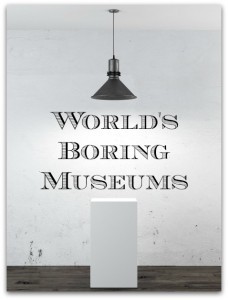 The British Lawnmower Museum (Merseyside, England)
The British Lawnmower Museum (Merseyside, England)Founded by a former race car driver whose family once sold lawnmower parts, the museum displays more than 200 lawnmowers, including ones souped up to race, 19th century lawnmowers, and a two-inch-tall working lawnmower.
The Musée du Papier Peint (Rixheim, France)
There are more than 1,000 examples on display, spanning the early 1800s to, for some reason 1983. Oh, you don’t speak French? The “Musée du Papier Peint” is the “Museum of Wallpaper.” Bonus: The museum also displays machines that have been used to make wallpaper.
The Dog Collar Museum (Leeds, England)
Leeds Castle is a pretty interesting place to visit, although inside its walls is the Dog Collar Museum. They’ve got more than 100 dog collars hanging from pegs.
Chez Galip Hair Museum (Avanos, Turkey)
Over the ages, women have used all kinds of clips, bands, and rings to style their hair or keep it in place. And you can see hundreds of them at this museum. (It’s not a hair museum; that would be weird.) Please note that the museum does accept donations…of hair clips.
Museum Cemento Rezola (San Sebastian, Spain)
Concrete is such a big part of modern, urban life, that it probably deserves a museum…but do we really need one? This place in Spain, founded by a Spanish cement company, is split into three areas: the history of cement, how cement is made, and how cement is used. The Museum is housed in a building made mostly out of glass. (Just kidding. It’s made of cement.)
The post The World’s Most Boring Museums? appeared first on .
The Hard Luck of Walter Egan
Another entry in our series on musicians who just couldn’t get the fair shake they deserved.
 In the late 1960s and early 1970s, guitarist/singer/and songwriter Walter Egan was part of the “California sound,” the burgeoning country-rock hybrid that would make superstars out of Linda Ronstadt and the Eagles. Egan got a record deal with his band Sageworth and Drum, but it fell apart in 1971, before the band made an album.
In the late 1960s and early 1970s, guitarist/singer/and songwriter Walter Egan was part of the “California sound,” the burgeoning country-rock hybrid that would make superstars out of Linda Ronstadt and the Eagles. Egan got a record deal with his band Sageworth and Drum, but it fell apart in 1971, before the band made an album.
However, in 1972 country rock icons Gram Parsons and Emmylou Harris opted to record “Hearts of Fire,” a song Egan wrote, for Parsons’ Grievous Angel. Scheduled for release in 1973, Angel was delayed when Parsons died of a drug overdose. The album would ultimately be regarded as one of the finest ever made, but it sold poorly and it lead to only a handful of session work gigs for Egan.
Four long years alter, Egan landed a contract with United Artists and he asked some of the biggest producers in the industry to help him make an album including Brian Wilson, Todd Rundgren, and John Fogerty. All turned him down. A friend suggested he ask guitarist Lindsey Buckingham to produce, who had just joined Fleetwood Mac with his girlfriend, Stevie Nicks. Buckingham agreed to produce the record, but things get awkward when after Buckingham and Nicks broke up, Egan and Nicks briefly dated
Fundamental Roll was released to little notice. Frustrated more by getting dumped by Nicks, Egan wrote a song called “Magnet and Steel.” The song appeared on his next album, Not Shy, in 1978, and it went to #8 on the pop chart. It was Egan’s first hit…biggest hit…and only hit.
In the early 1980s, Egan was invited to join Fleetwood Mac. However, no one from Fleetwood Mac has ever confirmed that the invite took place. After a string of low-selling albums, Egan recorded an album in 1983 called Walternative featuring guest shots from Jackson Browne and Christine McVie of Fleetwood Mac. Instead, Warner Bros. shelved it and doesn’t release it…until 1999.
What did Egan do in the mean time? Mostly session work. But in 1986, he appeared on the TV game show Scrabble and said his occupation was “famous musician. Host Chuck Woolery asked if the audience would know any of songs, so he sang the chorus of “Magnet and Steel.” The audience clapped politely; Egan does not win the game.
Back to 1999, the same year Egan’s Walternative was finally released, alternative rocker Matthew Sweet recorded a cover of “Magnet and Steel” for the Sabrina the Teenage Witch soundtrack album. What California rock musician with ties to Fleetwood Mac did Sweet enlist to play guitar and sing backup? Lindsey Buckingham.
The post The Hard Luck of Walter Egan appeared first on .
August 13, 2014
The Crazy Oreo and Kit-Kat Varieties Quiz
When Uncle John was young there were Oreos, and Double-Stuf Oreos, and one kind of Kit Kat bar. It’s a brave new world.
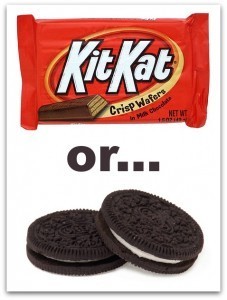 In the last couple of years, Nabisco has aggressively introduced more, and more crazy, flavors of the popular sandwich cookie. Over in Japan, the Kit Kat candy bar is extremely popular and similarly is available in dozens of seemingly bizarre flavors. Can you guess which of the following are weird Oreo flavors and which are weird Kit Kat flavors?
In the last couple of years, Nabisco has aggressively introduced more, and more crazy, flavors of the popular sandwich cookie. Over in Japan, the Kit Kat candy bar is extremely popular and similarly is available in dozens of seemingly bizarre flavors. Can you guess which of the following are weird Oreo flavors and which are weird Kit Kat flavors?
Banana Split
Chocobanana
Rainbow Sherbet
Brown Sugar
Strawberry Cheesecake
Candy Corn
Gingerbread
Pear
Watermelon
Fruit Parfait
Cookie Dough
Marshmallow Crispy
Cool Mint
Green Tea Ice Cream
Blueberry
Fruit Punch
Pumpkin
Answers:
Numbers 1, 3, 6, 7, 9, 11, 12, 13, 14, 15, and 16 are all real Oreo flavors (although technically speaking, the Rainbow Sherbet one is actually called “Rainbow Shure, Bert!”). Blueberry is available in Indonesia, and the Green Tea Ice Cream is a flavor available only in China.
Numbers 2, 4, 5, 8, 10, and 17 are Kit Kat bars from Japan. Among the other types you can get there: Edamame, Sweet Potato, Azuki Bean, Strawberry Fromage, Apricot Seed, “College Tater,” and “French Salt.”
The post The Crazy Oreo and Kit-Kat Varieties Quiz appeared first on .
August 8, 2014
Fake-or-Fact Friday: Weird Shopping Edition
What follows are three stories about clothing stores doing outlandish things to sell more product. Two of them are honest-to-goodness real, and the third one we made up. Can you tell which one is the fake? The answer is revealed at the end of the post.
A.
A plus-size clothing store is testing out a new concept at a soon-to-be-open store in London. Changing rooms will be outfitted with speakers that, if customers opt in, will play a prerecorded loop of compliments as they try on clothes. Among the self-esteem (and sales) boosting messages: “Girl, you look flawless,” “You’re a goddess on the inside and out,” and “Those shorts would look amazing with a logo tee.”
B.
The fashion industry has often been criticized for using too-skinny models that promote an unrealistic standard of beauty. Also troubling: how a garment looks on a model is probably a lot different than how it looks on a regular person. Solution: more “realistic” mannequins. A Chicago-based clothing company has introduced mannequins for use in its stores that instead of standing upright with good posture, are hunched over in “slouchy, casual poses” so the clothes look more like they would in the real world.
C.
A family clothing store in the San Francisco area has decided to bring back the bathroom attendant. But instead of hanging out in the restroom to dispense towels, mints, and cologne, the store is using them in fitting rooms and calling them “Changing Room Concierges.” The employees wait in the rooms and are there to hold clothing as customers try new things on, or can go fetch a different size of the garment from the sales floor, for example. Oh, and as soon as someone comes into their assigned fitting room, the concierges are required to put on a blindfold.
Want more fake facts? Then check out Uncle John’s Fake Facts. (Really!)
The post Fake-or-Fact Friday: Weird Shopping Edition appeared first on .
August 7, 2014
The Girl That Changed Lego
If you have something to say, write a letter. You might just get exactly what you want…even if you’re only seven years old.
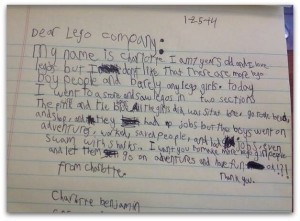 Some toys are considered “boy” toys and some toys are considered “girl” toys. But then there’s Lego, the building blocks favored by kids of every gender. Sets are available in every stripe, from the Old West to Middle Earth to Outer Space. There’s also a line called “Lego Friends” that’s marketed to girls—because the blocks are pink and purple. They’re mostly houses and shops. One other spot where there’s gender disparity in Lego: the Lego people, or “minifigs.” They are predominantly male.
Some toys are considered “boy” toys and some toys are considered “girl” toys. But then there’s Lego, the building blocks favored by kids of every gender. Sets are available in every stripe, from the Old West to Middle Earth to Outer Space. There’s also a line called “Lego Friends” that’s marketed to girls—because the blocks are pink and purple. They’re mostly houses and shops. One other spot where there’s gender disparity in Lego: the Lego people, or “minifigs.” They are predominantly male.
A seven-year-old girl named Charlotte Benjamin thought all of that that was pretty insulting. So, in January 2014 she wrote this letter to Lego headquarters (we’ve fixed the spelling errors; she was, after all, seven):
Dear Lego Company:
My name is Charlotte. I am 7 years old and I love Legos, but I don’t like that there are more Lego boy people and barely any Lego girls. Today I went to a store and saw Legos in two sections. The girls pink and the boys blue. All the girls did was sit at home, go to the beach, and shop. And they had no jobs but the boys went on adventure, worked, saved people, and had jobs, even swam with sharks. I want you to make more Lego girl people and let them go on adventures and have fun, ok!?! Thank you.
 How did Lego respond? They haven’t officially done so, but actions speak volumes. Earlier this month, they introduced a new set called the Research Institute. The 165-piece, $20 set allows kids to build a lively laboratory, including scientists mixing chemicals, building dinosaur bones into a T. rex, and using a telescope. The set comes with three minifig. The chemist is a woman.
How did Lego respond? They haven’t officially done so, but actions speak volumes. Earlier this month, they introduced a new set called the Research Institute. The 165-piece, $20 set allows kids to build a lively laboratory, including scientists mixing chemicals, building dinosaur bones into a T. rex, and using a telescope. The set comes with three minifig. The chemist is a woman.
Charlotte Benjamin must not have been the only one clamoring for better Lego options for and featuring girls and women: the Research Institute set is completely sold out and to buy one now requires at least a 30-day wait.
The post The Girl That Changed Lego appeared first on .
6 Weird Archie Moments
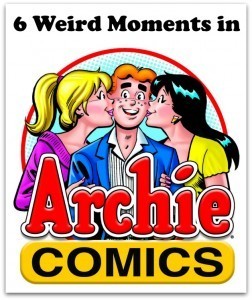 You’ve probably heard by now
that Archie Andrews, “America’s favorite teenager” is being killed off after more than 60 years in comics. But that’s only one of the weirdest things that’s ever happened to the Riverdale gang.
You’ve probably heard by now
that Archie Andrews, “America’s favorite teenager” is being killed off after more than 60 years in comics. But that’s only one of the weirdest things that’s ever happened to the Riverdale gang.
Archie is among the lightest comic books. The Punisher is among the darkest, concering a vigilante who avenges the death of his family by murdering any and all criminals. In the 1994 comic book The Punisher Meets Archie, the Punisher follows a drug kingpin to Riverdale, who’s pretending to be a gym teacher, and who is also Archie’s doppelganger. (Everything gets sorted out before the Punisher kills Archie.)
Teen idol Glenn Scarpelli joined the cast of One Day at a Time in 1980 to boost ratings. Around the same time, he—as himself, not his sitcom character—inexplicably became a regular character in Archie comics. Like the real Scarpelli, the comic Scarpelli played music and was well liked by girls. Why the crossover? Scarpelli is the son of Henry Scarpelli, a longtime writer of Archie comics.
In 1990, NBC aired a made-for-TV movie called Archie: To Riverdale and Back Again. It depicted what the lives of Archie, Betty, Veronica, and the rest were like…after they graduated high school. And those lives weren’t great. Archie is an unhappy lawyer, Betty is stuck in a bad relationship, and Jughead is a single dad who is out of touch with his son. (He gets through to him by performing a rap version of the Archies’ 1969 hit “Sugar Sugar.”)
During the 2008 election cycle, then-presidential candidate Barack Obama and vice-presidential candidate (on the other ticket) Sarah Palin both appeared in two issues of Archie. They ultimately set aside their differences to share a milkshake. (Really.)
In a 2010 issue of Life With Archie, the grumpy high school teacher Miss Grundy found love with school principal Mr. Weatherbee. They married, and shortly thereafter, she died of cancer.
In 1990, Archie Comics Group published Jughead’s Diner. A spinoff from the regular Archie stories, it featured burger-loving Jughead doing what he was meant to do: run a diner. However, the diner was populated by aliens and creatures from other dimensions. That lead to another series called Jughead’s Time Police. The premise: Jughead’s crown is a time machine. At one point he uses it to meet and fall in love with January McAndrews, a 29th century descendant of his best friend, Archie.
The post 6 Weird Archie Moments appeared first on .



